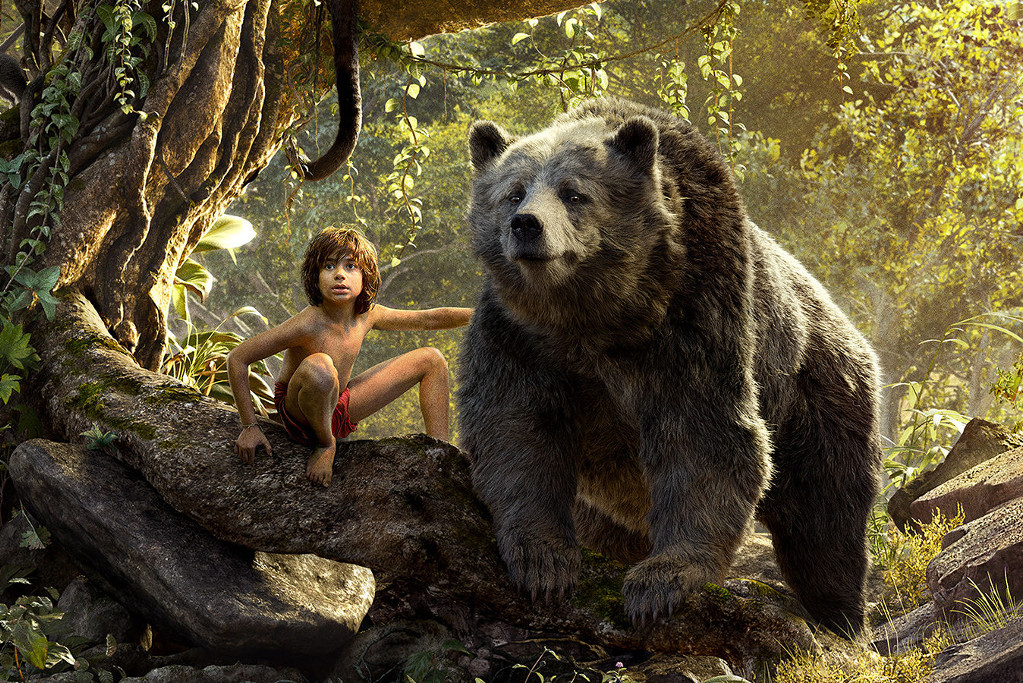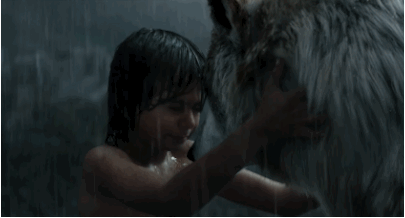‘The Jungle Book’ Review: Let’s All Go Live In The Wild Immediately
This movie feels like the real thing.

The final credits of Disney’s latest rebooted tale boast that it was “filmed in downtown Los Angeles”, and it’s a fact that’s well worth getting smug about. The Jungle Book’s greatest achievement (and its greatest irony) is that the Mowgli’s (Neel Sethi) wilderness home doesn’t exist in a tangible sense, nor do his animal frenemies. They were completely contrived by Man, right down to the last whisker.
When Canadian theorist Marshall McLuhan famously wrote, “the medium is the message”, he meant that each technological innovation introduces structural changes into our lives, with personal and social consequences. And this film is definitely a landmark visual effects achievement; it’s rendered so beautifully that even though it’s almost entirely unreal, it doesn’t seem silly to call it ‘live action’.
–
“I Wan’na Be Like You”: An Exquisitely Immersive World
Director Jon Favreau — who was, like Louie, a onetime king of the swingers — has called The Jungle Book his answer to James Cameron’s Avatar. His jungle is a fantastical dreamscape that encompasses grassy plains, deep-cut river gullies and rocky outcrops along with lush rainforest. And Favreau thrusts the viewer into its depths, right from the opening dolly shot, which slinks back from the Disney castle into the jungle.
The cinematography keeps our eyes roving fluidly above, below, around and through logs, leaves, rocks and water. And it follows Mowgli in the same mode of Disney’s earlier feral child, Tarzan: threading his way nimbly through the forest with Bagheera (Ben Kingsley) and his wolf-cub brothers. (The thought of the LA jungle gym in which Sethi was really being filmed is nearly as exhilarating as the finished shot.)
But while previous Disney films — from the 1967 animated Jungle Book to The Lion King (1994) and Tarzan (1999) — adopted an impressionistic, painterly approach to their settings, Favreau wants nothing to break the illusion that this world is real. Mowgli is almost the only human onscreen, but he interacts seamlessly with his CGI co-stars. When he hugs his wolfmother, Raksha (Lupita Nyong’o), his face and hands sink into her shaggy fur. I was so immersed in their interactions that I cried when Raksha fiercely reminds Mowgli that he’ll always be her cub.

Computer-generated onscreen animals haven’t always been so frictionless. Jurassic Park’s (1993) dinosaurs looked convincing because they judiciously mixed CGI with puppetry and animatronics (and because there’s still so much debate over how dinosaurs really looked and behaved). But the 1990s were an uncanny time for CGI beasties; one which led us to instantly notice when familiar animals looked ‘wrong’ onscreen.
There were Jumanji’s painfully fake-looking monkeys in 1995; the ridiculous shark that ends Samuel L. Jackson in Deep Blue Sea (1999); the plasticky snake in so-bad-it’s-brilliant cult film Anaconda (1997); and the monstrous alligator in Eraser (1996) that Arnold Schwarzenegger converts to luggage. Of course, crappy CGI animals have persisted since. Who could forget the wacky cat-attack scene from Let the Right One In (2008)?
Effects house Rhythm & Hues has set the standard in the CGI subgenre we could call “animated snouts” in films including Babe (1995), Cats and Dogs (2001) and Charlotte’s Web (2006). Their photorealistic fantasy animals also appear in The Chronicles of Narnia: The Lion, The Witch and the Wardrobe (2005), The Golden Compass (2007) and Life of Pi (2012) — the latter two films even won Academy Awards in visual effects.
–
“The Bare Necessities”: What Does This Film Actually Say?
Of all the intellectual properties Disney could have resurrected, why this one? What does this story have to tell us, now? One critic dubbed it “a Heart of Darkness for kids”, with King Louie as a Colonel Kurtz-like figure. Another even called it “The Revenant for kids”. I mean, come on.

BALOO, NO!
A third critic suggested that, in a time of refugee crisis, this is a parable of inclusion and diversity, with Mowgli as a brown-skinned immigrant violently rejected by an insular conservatism represented by Shere Khan, but aided by a supportive community. Sure, the film emphasises Kipling’s ‘Law of the Jungle’ (“the strength of the wolf is the pack”) and features a ‘water truce’, during which the animals agree not to prey on each other during the dry season. But this allegorical animal polity is only ever a subtext; Disney’s recent Zootopia tackles similar themes far better.
Having saved all its innovation for the visuals, the plot is noticeably bland and desultory. Bagheera’s just there, his mentorship of Mowgli unexplained. Shere Khan lacks his key characteristic: his fear of fire. He’s basically a semi-invincible sociopath with a personal vendetta against Mowgli.
It’s a ramble in the jungle: a string of spectacular setpieces that largely follows the template of the 1967 cartoon, with a little bit of Lion King-style buffalo stampeding thrown in. Yes, Baloo still sings ‘The Bare Necessities’, and King Louie sings ‘I Wan’na Be Like You’ — but mainly because Favreau knows audiences are expecting these moments. The giant python Kaa’s (Scarlett Johansson) hypnotism of Mowgli, and his visit to Louie’s ‘court’ in an abandoned temple, seem to happen purely because they have before.
The story of this film is its consummate technical achievement. If I’m to join my fellow critics in drawing analogies, perhaps man’s “red flower”, craved by Louie and feared by Shere Khan, isn’t just fire; it’s technology. Humans don’t need a wolf pack to become something more than ourselves. To quote the title of Marshall McLuhan’s 1964 book, our technologies are The Extensions of Man.
We can extend ourselves for good — as in the Tarzan-esque contraptions of vines, stones and leaves that Bagheera dismissively calls Mowgli’s ‘tricks’ — or for ill, as in the flaming torch that maimed Shere Khan and sparked his xenophobia. Tools can even escape control altogether, as in the wildfires that ravage the jungle.
But one of the oddest ideas here is Bagheera’s claim that elephants are mystical animals to be honoured because they “shaped the jungle”. Perhaps Disney sees itself as a similar creative behemoth, with a long memory and an urge to trample and rebuild what’s come before.
–
The Jungle Book is in cinemas now.
–
Mel Campbell is a freelance journalist and cultural critic. She blogs on style, history and culture at Footpath Zeitgeist and tweets at @incrediblemelk.